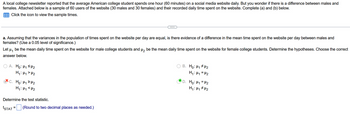
A First Course in Probability (10th Edition)
10th Edition
ISBN: 9780134753119
Author: Sheldon Ross
Publisher: PEARSON
expand_more
expand_more
format_list_bulleted
Question
thumb_up100%
This is a practice assignment.

Transcribed Image Text:Sample times
Daily time spent (in minutes) on the website for 30 males
180 960 60 30 10
5 720 300 60 180 180 180 210 210 180
60 90 270 45 150 30 45 45 180 60 15 30 15 120 120
Daily time spent (in minutes) on the website for 30 females
45 15 180 90 120 150
120 30 30 90 150
45 60 30
60 60 240
75
15 100 60 60 90 150
60 20 120 30 120 105

Transcribed Image Text:A local college newsletter reported that the average American college student spends one hour (60 minutes) on a social media website daily. But you wonder if there is a difference between males and
females. Attached below is a sample of 60 users of the website (30 males and 30 females) and their recorded daily time spent on the website. Complete (a) and (b) below.
Click the icon to view the sample times.
a. Assuming that the variances in the population of times spent on the website per day are equal, is there evidence of a difference in the mean time spent on the website per day between males and
females? (Use a 0.05 level of significance.)
Let μ, be the mean daily time spent on the website for male college students and μ₂ be the mean daily time spent on the website for female college students. Determine the hypotheses. Choose the correct
answer below.
OA. Ho: H₁ H₂
H₁: H₁ H₂
C. Ho: H₁ H₂
H₁ H₁ <H₂
Determine the test statistic.
tSTAT =
(Round to two decimal places as needed.)
B. Ho: ₁ ₂
H₁: H₁ = H₂
D. H₂:₁ = H₂
H₁: H₁ H₂
Expert Solution
This question has been solved!
Explore an expertly crafted, step-by-step solution for a thorough understanding of key concepts.
This is a popular solution
Trending nowThis is a popular solution!
Step by stepSolved in 5 steps with 12 images

Follow-up Questions
Read through expert solutions to related follow-up questions below.
Follow-up Question
In addition to equal variances, what other assumption is necessary in (a)?
A.
In addition to equal variances, it must be assumed that the population sizes are equal.
B.
In addition to equal variances, no other assumptions must be made because the sample sizes are large enough (greater than or equals 30 for each sample).
C.
In addition to equal variances, it must be assumed that the samples are specifically chosen and not independently sampled.
D.
In addition to equal variances, it must be assumed that the sample means are equal.
Solution
by Bartleby Expert
Follow-up Questions
Read through expert solutions to related follow-up questions below.
Follow-up Question
In addition to equal variances, what other assumption is necessary in (a)?
A.
In addition to equal variances, it must be assumed that the population sizes are equal.
B.
In addition to equal variances, no other assumptions must be made because the sample sizes are large enough (greater than or equals 30 for each sample).
C.
In addition to equal variances, it must be assumed that the samples are specifically chosen and not independently sampled.
D.
In addition to equal variances, it must be assumed that the sample means are equal.
Solution
by Bartleby Expert
Knowledge Booster
Similar questions
- Could you perhaps draw this?arrow_forwardRule1: If today is rain then tomorrow is rainy certainty factor 0.5 Rule2: if today is dry then tomorrow is dry is certainty factor 0.5 Rule3: if today is rain and the rainfall is low then tomorrow is dry is cf 0.6 Rule4: if today is rain and rainfall is low and temperature is cold, then tomorrow is dry is certainty factor 0.7 Rule5: if today is dry and temperature is cold then tomorrow is rain is cf 0.65. Rule6: if today us dry and temperature is cold sky is overcast then tomorrow is cf 0.55 Base on the information provided by the user, today is rain certainty factor is 1.0 and certainty factor for rainfall is low is 0.8 and the temperature is cold is 0.9. What certainty factor (cf) should be assigned to hypothesis ? 1. Tomorrow is dry 2. Tomorrow is rainarrow_forwardIs this fully simplifed ?arrow_forward
arrow_back_ios
arrow_forward_ios
Recommended textbooks for you
 A First Course in Probability (10th Edition)ProbabilityISBN:9780134753119Author:Sheldon RossPublisher:PEARSON
A First Course in Probability (10th Edition)ProbabilityISBN:9780134753119Author:Sheldon RossPublisher:PEARSON

A First Course in Probability (10th Edition)
Probability
ISBN:9780134753119
Author:Sheldon Ross
Publisher:PEARSON
